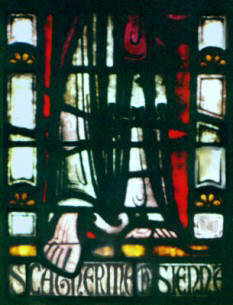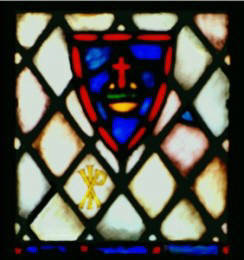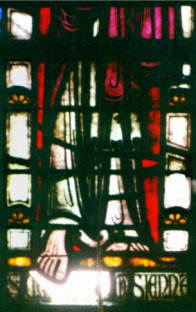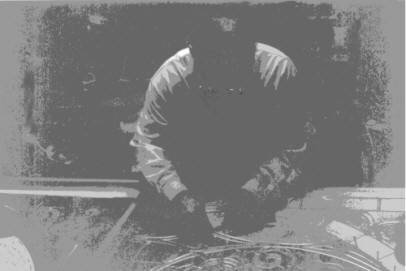JOSEPH TRACY *@ * BROOKSIDE GLASSWORKS * 802-694-1590 *CONSERVATION WORK* PAGE 1
The windows on this page represent a common kind of restorative procedure. They are vent windows, which endure greater than averege wear and tear.
The ideal of architectural conservation is to restore a work to the full required structural integrity, while keeping the character of the original intact. The conservator must leave as much original material as possible and match the color, the measurements, the painting style and the fabrication techniques of the original.
The windows above and below are in a gothic revival style, which uses one layer of glass, usually painted with a diffusing matte layer and darker shading and trace lines. The yellow symbol is painted with silver stain, the only true stain in stained glass. The lead "cames" used here were a combination of flat wide leads and narrower rounded leads. We always use the sizes and conformations of the original, sometimes upgrading the strength and quality.
So let me walk you through the basics of a stained glass restoration...

..., with asides for different procedures and challenges and for my take on the philosophical issues that come up in glass conservation. A project begins with a quality assessment of the condition of the windows. While some things, like the missing glass shown on this page are obvious, many others, like hairline cracks, flaking paint, brittle leads, loose tie wires, unsound installation methods, etc. require an expert observer. Ask questions, check references; the integrity, knowledge, and precision of the initial assessor is critical. ...(continued next page)
Christ the King, Rutland, VT:Some repairs call for the re-construction of artistic style. I love glass painting and the challenge of trying to understand how a given effect, texture or tonality was achieved. Glass paint is a powdered silicate frit, pigmented with metal oxides. It is fired in a kiln, and melts onto the glass in a permanent bond.







